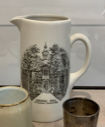American Decorators does not have an image.
American Decorators
American, (1850–1940)
For more than 100 years, Trenton, New Jersey was one of the two major pottery centers in the United States, the other being located at East Liverpool, Ohio. In 1850, the only pottery in Trenton was a small redware pottery operated by the McCully family. The development of a major industry in Trenton started with the opening of two potteries in 1853. Taylor and Speeler began production of a line of Rockingham in May 1853. It was followed shortly thereafter by William Young & Co. William Young, together with his sons and Richard Millington and John Astbury were associated in this endeavor for about six years. These two companies formed the nucleus of a rapidly expanding industry. Within ten years, there were ten potteries in Trenton. This number grew to fifteen by 1870 and reached 23 in 1883. At its zenith in the 1920’s, Trenton had more than fifty potteries operating throughout the City. Since 1850, more than 150 companies have operated in Trenton.
There has never been a comprehensive history of Trenton potteries largely because of the massive scale of the industry. It is ironic that Trenton’s success as a pottery center has made it difficult to chronicle this history. As a pottery center, Trenton made innumerable contributions to the development of the pottery industry in America. Trenton is responsible for the introduction of wide scale production of white graniteware. This product enabled American potters to compete successfully with foreign producers, particularly the English. The production of sanitary ware originated in Trenton and greatly assisted the growth of the American pottery industry. Trenton also pioneered the development of art porcelain through the introduction in 1882 of “Belleek” china. Using techniques developed at the Irish Belleek works, Trenton became the base for high quality art porcelains.
Between 1880 and the Depression in the late 1920s and early 1930s, Trenton reached its zenith as a center of industrial pottery production. Factories large and small ranged across the city, tied to the all-important canal and railroad network that gave access to the outside world. City directories published between 1901 and 1918 list between 38 and 47 pottery establishments, reaching a peak of 52 facilities in 1924. The number of plants dwindled to around 30 at the time of the Depression and by the end of World War II only 18 were listed as being in operation. While the Depression was responsible for much of the industry’s decline, many factories closed during World War II when energy resources were redirected from consumer goods to the manufacture of war materials. Other factors that contributed to the decline included labor disputes, resistance to the introduction of new labor-saving technologies, and the increasing use of plastics in the home.
Source: potteriesoftrentonsociety.org
American, (1850–1940)
For more than 100 years, Trenton, New Jersey was one of the two major pottery centers in the United States, the other being located at East Liverpool, Ohio. In 1850, the only pottery in Trenton was a small redware pottery operated by the McCully family. The development of a major industry in Trenton started with the opening of two potteries in 1853. Taylor and Speeler began production of a line of Rockingham in May 1853. It was followed shortly thereafter by William Young & Co. William Young, together with his sons and Richard Millington and John Astbury were associated in this endeavor for about six years. These two companies formed the nucleus of a rapidly expanding industry. Within ten years, there were ten potteries in Trenton. This number grew to fifteen by 1870 and reached 23 in 1883. At its zenith in the 1920’s, Trenton had more than fifty potteries operating throughout the City. Since 1850, more than 150 companies have operated in Trenton.
There has never been a comprehensive history of Trenton potteries largely because of the massive scale of the industry. It is ironic that Trenton’s success as a pottery center has made it difficult to chronicle this history. As a pottery center, Trenton made innumerable contributions to the development of the pottery industry in America. Trenton is responsible for the introduction of wide scale production of white graniteware. This product enabled American potters to compete successfully with foreign producers, particularly the English. The production of sanitary ware originated in Trenton and greatly assisted the growth of the American pottery industry. Trenton also pioneered the development of art porcelain through the introduction in 1882 of “Belleek” china. Using techniques developed at the Irish Belleek works, Trenton became the base for high quality art porcelains.
Between 1880 and the Depression in the late 1920s and early 1930s, Trenton reached its zenith as a center of industrial pottery production. Factories large and small ranged across the city, tied to the all-important canal and railroad network that gave access to the outside world. City directories published between 1901 and 1918 list between 38 and 47 pottery establishments, reaching a peak of 52 facilities in 1924. The number of plants dwindled to around 30 at the time of the Depression and by the end of World War II only 18 were listed as being in operation. While the Depression was responsible for much of the industry’s decline, many factories closed during World War II when energy resources were redirected from consumer goods to the manufacture of war materials. Other factors that contributed to the decline included labor disputes, resistance to the introduction of new labor-saving technologies, and the increasing use of plastics in the home.
Source: potteriesoftrentonsociety.org
Artist Objects
